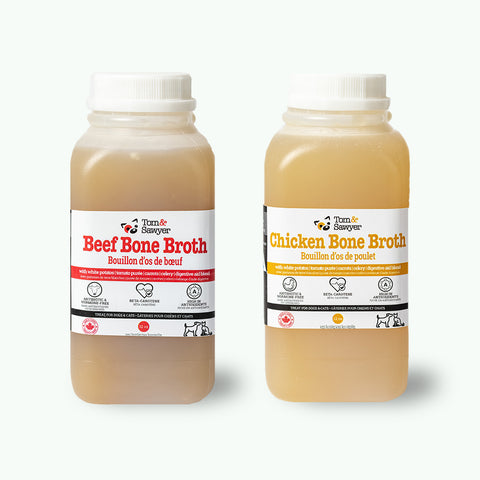Understanding Arthritis in Dogs: Prevention, and Nutrition
Are you noticing that your once-spry dog is now walking a little stiffer, and moving a little slower? It may be an indication of osteoarthritis, and can be a painful and unpleasant diagnosis.
In this article, we explore the topic of arthritis in dogs, including its signs, causes, treatment, and how Tom&Sawyer's wholesome, gently-cooked meals can play a pivotal role in prevention.

Understanding Arthritis in Dogs
Osteoarthritis is a degenerative joint disease that is a common ailment among our canine friends, especially seniors and large breeds. Unlike some conditions that can be cured outright, arthritis is chronic and requires ongoing management.
Let’s break it down:
- What Is Osteoarthritis?
-
Osteoarthritis occurs due to the gradual deterioration of joint cartilage. In a healthy joint, cartilage acts as a cushion, allowing smooth movement. However, factors like age, injury, repetitive stress, excess body fat mass, or disease can all lead to cartilage breakdown.
The result? Pain, inflammation, limited range of motion, and the formation of bone spurs.
While any joint can be affected, osteoarthritis most commonly impacts limbs and the lower spine.
- Signs and Symptoms
- Detecting early signs of osteoarthritis can be challenging, as some dogs are stoic and hide their pain. However, some symptoms to look for with arthritis includes:
- Stiffness, limping, or difficulty getting up
- Lethargy
- Reluctance to run, jump, or play
- Weight gain
- Irritability or behaviour changes
- Pain when touched
- Muscle loss over limbs and spine
- Risk Factors
- Certain factors increase the likelihood of osteoarthritis:
- Large or giant breeds, specifically, improper growth and development as puppies
- Overweight or obese dogs are at greater risk
- Repetitive stress from athletic activities
- Prior injuries (i.e. fractures, ligament tears)
- Hip or elbow dysplasia
- Infections affecting joints (i.e., Lyme Disease)
- Genetics and poor conformation
Managing Arthritis: Treatment and Prevention
- Treatment Focus
- While there’s no cure for osteoarthritis, early detection and appropriate management can improve your dog’s quality of life.
Treatment aims to: - Control pain
- Decrease inflammation
- Enhance overall well-being
- Slow disease progression
- If you believe that your dog is exhibiting signs of osteoarthritis seek veterinary care.
- Nutrition Matters
- Diet can play a role within a treatment or management plan. Some nutrients to look for include:
- Omega-3 Fatty Acids: High-quality fish oils provide these essential nutrients. They support joint health and reduce inflammation. They have high evidence through clinical trials for their efficacy in reducing symptoms of osteoarthritis in dogs.
- Glucosamine and Chondroitin: These naturally occurring compounds promote joint cartilage function. While there is less clinical evidence for their efficacy, some reports suggest improvements in symptoms.
- Antioxidants: Diets rich in antioxidants can be beneficial in reducing oxidative stress that can occur with osteoarthritis though there is a dearth of research available for their clinical efficacy.
-
Collagen: A few, smaller scale studies, have shown some benefits of collagen-based ingredients and symptoms of osteoarthritis. Collagen is an integral component to cartilage and the strength and flexibility of the connective tissue at the joint. Bone broths can provide a source of collagen and collagen can be naturally present in animal derived ingredients.

Preventing Osteoarthritis: A Holistic Approach
- Dietary Choices
- Tom&Sawyer's fresh pet food is ideal for prevention:
- Customized: We have meal plans that can be developed based on your dog’s individual needs, ensuring optimal nutrition and portion sizes.
- Omega 3 Fatty Acids: All of our meals contain a rich source of omega-3’s and are within the appropriate omega-6 to omega-3 ratios that are considered to be beneficial for anti-inflammation.
- Rich in Antioxidants: Reducing oxidative stress can play a role in keeping your pup and their joints healthy as they age!
-
Supports Healthy Aging: Although age itself is not a direct cause for osteoarthritis, aging can increase the risk for arthritis. A nutritious diet to support healthy aging and senior pups can help!

- Exercise and Weight Management
- Regular, low-impact exercise keeps joints moving.
- Maintain a healthy weight to reduce strain on joints.
- Diet can play an important role in weight management. We have a line of low-fat recipes that may be an option for pups carrying a bit of extra weight. For a guide to safe weight loss in dogs, you can read our previous blog post here.
- Holistic Supplements
- Bone broths contain collagen, an integral component to cartilage and the strength and flexibility of the connective tissue at the joint. Adding bone broth to your dog’s food as a topper on their daily meals is an easy and natural way to introduce additional collagen into their diets.
Remember, a proactive approach is key. Regular wellness visits to your veterinarian help catch signs early and ensure your dog’s overall health. Together, we can keep our furry companions active, happy, and thriving! 🐾
Written by: Hannah Godfrey
Animal Nutritionist
BSc.H. | MSc. Animal Nutrition
www.tomandsawyer.com
References:
- Barbeau- Grégoire M, et al.2022 systematic review and meta-analysis of enriched therapeutic diets and nutraceuticals in canine and feline osteoarthritis. International Journal of Molecular Science. 2022.
- Bauer JE. Responses of dogs to dietary omega-3 fatty acids. Timely Topics in Nutrition. 2007.
- Bland SD. Canine osteoarthritis and treatments: a review. Veterinary Science Development. 2015.
- Budsberg SC, Bartges JW. Nutrition and osteoarthritis in dogs: does it help? Veterinary Clinics of North America: Small Animal Practice. 2006.
- Deparle LA, et al. Efficacy and safety of glycosylated undernatured type-II collagen (UC-11) in therapy or arthritic dogs. Journal of Veterinary Pharmacology and Therapeutics. 2005.
- Kaur H. Role of omega-3 fatty acids in canine health: a review. International Journal of Current Microbiology and Applied Sciences. 2020.
- Case LP et al. Canine and Feline Nutrition: A Resource for Companion Animal Professionals 3rd Ed. 2010.
- National Research Council. (2006). Nutrient requirements of dogs and cats.
- Hand MS, et al (ed.) Small animal clinical nutrition, 4th ed. Topeka, KS: Mark Morris Institute. 2000.












